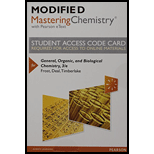
Modified Mastering Chemistry with Pearson eText -- Standalone Access Card -- for General, Organic, and Biological Chemistry (3rd Edition)
3rd Edition
ISBN: 9780134143705
Author: Laura D. Frost, S. Todd Deal
Publisher: PEARSON
expand_more
expand_more
format_list_bulleted
Question
Chapter 5, Problem 5.33PP
Summary Introduction
To draw:
The products formed in the condensation reaction of ethanoic acid and ethanol.
Introduction:
Atoms consist of three subatomic particles namely proton, electron and neutron. Out of these subatomic particles only electrons are involved in bonding. The formation of bond between two species is always due to the involvement of electrons either it undergoes loss of electrons or gains of electrons.
Expert Solution & Answer
Want to see the full answer?
Check out a sample textbook solution
Students have asked these similar questions
Draw the main product for the ester formed through the condensation reaction shown
give an example of an esterification reaction using hexanoic acid that will result in an ester
Draw the products of the hydrolysis reaction between the ester molecule and water.
Chapter 5 Solutions
Modified Mastering Chemistry with Pearson eText -- Standalone Access Card -- for General, Organic, and Biological Chemistry (3rd Edition)
Ch. 5 - When vinegar (CH3COOH) and baking soda (NaHCO3)...Ch. 5 - In your own words, define free energy change, G....Ch. 5 - Classify the following as exothermic or...Ch. 5 - Prob. 5.4PPCh. 5 - Prob. 5.5PPCh. 5 - Classify the following as spontaneous or...Ch. 5 - Prob. 5.7PPCh. 5 - Prob. 5.8PPCh. 5 - Prob. 5.9PPCh. 5 - Prob. 5.10PP
Ch. 5 - a. How does increasing the temperature increase...Ch. 5 - a. Describe activation energy for a chemical...Ch. 5 - Why does the rate of a chemical reaction decrease...Ch. 5 - Prob. 5.14PPCh. 5 - Enzymes increase the rate of a biological chemical...Ch. 5 - Prob. 5.16PPCh. 5 - Prob. 5.17PPCh. 5 - Prob. 5.18PPCh. 5 - Categorize the following reactions as synthesis,...Ch. 5 - Categorize the following reactions as synthesis,...Ch. 5 - Prob. 5.21PPCh. 5 - Prob. 5.22PPCh. 5 - Write the products and balance the following...Ch. 5 - Prob. 5.24PPCh. 5 - Prob. 5.25PPCh. 5 - List the differences between general chemical...Ch. 5 - Are the substances shown in italics undergoing...Ch. 5 - Prob. 5.28PPCh. 5 - Prob. 5.29PPCh. 5 - Prob. 5.30PPCh. 5 - Prob. 5.31PPCh. 5 - Prob. 5.32PPCh. 5 - Prob. 5.33PPCh. 5 - Prob. 5.34PPCh. 5 - Prob. 5.35PPCh. 5 - Prob. 5.36PPCh. 5 - Prob. 5.37PPCh. 5 - Write the main product of hydration for the...Ch. 5 - Methane (a.k.a. natural gas) can react with oxygen...Ch. 5 - Prob. 5.40APCh. 5 - Which reaction occurs at a faster rate, an...Ch. 5 - Prob. 5.42APCh. 5 - Prob. 5.43APCh. 5 - Two curves for the same reaction are shown in the...Ch. 5 - Prob. 5.45APCh. 5 - Draw and label a reaction energy diagram for an...Ch. 5 - Prob. 5.47APCh. 5 - Prob. 5.48APCh. 5 - Write the products that would result from the...Ch. 5 - Prob. 5.50APCh. 5 - Prob. 5.51APCh. 5 - Prob. 5.52APCh. 5 - Prob. 5.53APCh. 5 - Prob. 5.54APCh. 5 - Prob. 5.55APCh. 5 - Identify the reactant that is oxidized and the...Ch. 5 - Prob. 5.57APCh. 5 - Write the products of the following reactions:Ch. 5 - Prob. 5.59APCh. 5 - Acetylsalicylic acid (aspirin) can be synthesized...Ch. 5 - Prob. 5.61APCh. 5 - Fill in the missing organic produce for the...Ch. 5 - Prob. 5.63APCh. 5 - Prob. 5.64APCh. 5 - How do low-carb diets work? We store glucose...Ch. 5 - Prob. 5.66CPCh. 5 - Prob. 5.67CPCh. 5 - Prob. 5.68CPCh. 5 - Prob. 5.69CPCh. 5 - Which reaction has the larger activation energy?Ch. 5 - Prob. 1IA.2QCh. 5 - A catalyst speeds up a chemical reaction by...Ch. 5 - Prob. 1IA.4QCh. 5 - Examine your sketch from question 3. Does a...Ch. 5 - Prob. 1IA.6QCh. 5 - Prob. 2IA.1QCh. 5 - Prob. 2IA.2QCh. 5 - Prob. 2IA.3QCh. 5 - One of the reactions in the data set is a single...Ch. 5 - Prob. 2IA.5QCh. 5 - Categorize the following reactions as a synthesis,...Ch. 5 - Prob. 3IA.1QCh. 5 - Prob. 3IA.2QCh. 5 - Prob. 3IA.3QCh. 5 - Prob. 3IA.4QCh. 5 - Prob. 3IA.5QCh. 5 - Prob. 1ICCh. 5 - Find out how unsaturated fats are saturated and...
Knowledge Booster
Similar questions
arrow_back_ios
arrow_forward_ios
Recommended textbooks for you
 Introductory Chemistry: An Active Learning Approa...ChemistryISBN:9781305079250Author:Mark S. Cracolice, Ed PetersPublisher:Cengage Learning
Introductory Chemistry: An Active Learning Approa...ChemistryISBN:9781305079250Author:Mark S. Cracolice, Ed PetersPublisher:Cengage Learning

Introductory Chemistry: An Active Learning Approa...
Chemistry
ISBN:9781305079250
Author:Mark S. Cracolice, Ed Peters
Publisher:Cengage Learning